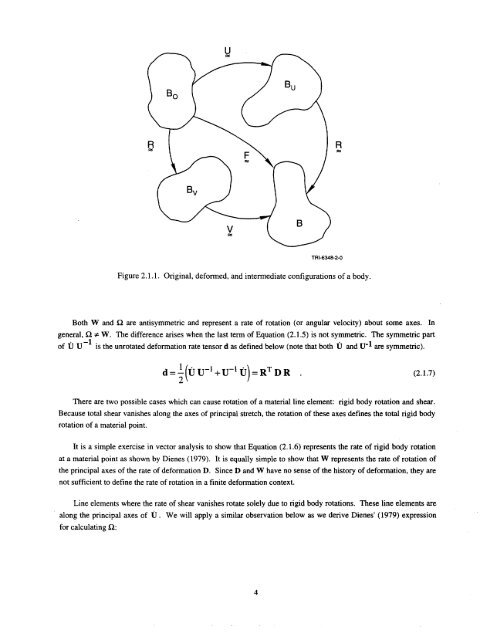II II II II II I - Waste Isolation Pilot Plant - U.S. Department of Energy
II II II II II I - Waste Isolation Pilot Plant - U.S. Department of Energy
II II II II II I - Waste Isolation Pilot Plant - U.S. Department of Energy
- No tags were found...
Create successful ePaper yourself
Turn your PDF publications into a flip-book with our unique Google optimized e-Paper software.
TRI-6L4S-2-O<br />
Figure 2.1.1. Original, deformed, and intermediate configurations <strong>of</strong> a body.<br />
Both W and fZ are antisymmetric and represent a rate <strong>of</strong> rotation (or angular velocity) about some axes. In<br />
general, Q #W. The difference arises when the last term <strong>of</strong> Equation (2.1.5) is not symmetric. The symmetric part<br />
<strong>of</strong> u U-l “K the unrotated deformation rate tensor d as defined below (note that both U and WI are symmetric).<br />
d=#UU-l+U-%)=RTDR . (2. 1.7)<br />
There are two possible cases which can cause rotation <strong>of</strong> a material line element: rigid body rotation and shear.<br />
Because total shear vanishes along the axes <strong>of</strong> principal stretch, the rotation <strong>of</strong> these axes defines the total rigid body<br />
rotation <strong>of</strong> a material point.<br />
It is a simple exercise in vector analysis to show that Equation (2.1.6) represents the rate <strong>of</strong> rigid body rotation<br />
at a material point as shown by Dienes (1979). It is equally simple to show that W represents the rate <strong>of</strong> rotation <strong>of</strong><br />
the principal axes <strong>of</strong> the rate <strong>of</strong> deformation D. Since D and W have no sense <strong>of</strong> the history <strong>of</strong> deformation, they are<br />
not sufficient to define the rate <strong>of</strong> rotation in a finite deformation context.<br />
Line elements where the rate <strong>of</strong> shear vanishes rotate solely due to rigid body rotations. These line elements are<br />
along the principal axes <strong>of</strong> U. We will apply a similar observation below as we derive Dienes’ (1979) expression<br />
for calculating !2:<br />
4
















